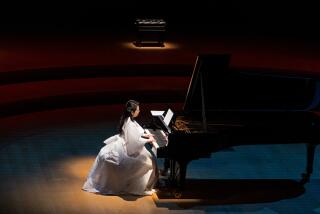MUSIC REVIEW : Classical Success in the Key of Simplicity
ORANGE — Pianist James Barbagallo and tenor Alan Bowers proved over the weekend that simplicity can be the surest way to success. In a shared recital before a small audience in Salmon Recital Hall on Friday night, the two opened the third annual Summer Seminar for pianists and singers at Chapman College.
Barbagallo, in particular, brought a straightforward and often understated approach to his performance. In Mozart’s Sonata in B-flat Major, K. 570, the pianist employed a clear delicacy to create an amiable atmosphere. As part of his effort to maintain a good-natured ambience, Barbagallo tamed details--such as the marcato markings in the third-movement Allegretto--that might have obstructed his goals. The Adagio emerged as a quiet, intimate song.
Barbagallo offered two subtly shaded nocturnes by Chopin, Op. 62, No. 2 and Op. 9, No. 3, as the closing pieces of the program. Here, he used a tastefully refined rubato and, though he glossed over some of the more telling dissonances in the earlier opus, he achieved an attractive cantabile.
The final work in the set, Chopin’s 1st Scherzo, contrasted a fiery facility with a simple lento respite. Barbagallo marked the abrupt changes of the presto sections by pedaling to suspend previous harmonies into current chords. He finished with an exciting, clamorously powerful but ever polished coda.
Bowers also avoided unnecessary dramatics during his work with accompanist Timothy Steele. In Beethoven’s cycle ‘An die ferne Geliebte,’ the tenor gave expressive attention to text and phrasing despite a raspy edge to the voice that periodically crept into soft, high sections.
Pianist and singer were attentive to one another. In “Es kehret der Maien, es bluhet die Au,” the fifth song in the cycle, Bowers turned tellingly to listen to Steele’s introduction from which he drew his caressingly wistful mood. Steele, who leaves after this weekend to begin a free-lance career in Boston, supported with movingly emphasized, colorful chord changes.
Following intermission, Bowers concentrated on two sets of works by conservative 20th-Century American and English composers. He infused the first, three of five pleasantly impressionistic songs from Louise Talma’s cycle “Terre de France,” with a quiet sensitivity to floating melodies.
The four sentimental love songs that composed the second set were saved from a descent into maudlin nostalgia by Bowers’ serious delivery. Most captivating among these was Frank Bridge’s “Love Wene A’Riding,” marked by a dramatic flair that Bowers had already demonstrated in an excerpt from “Joseph,” by Mehul.
More to Read
The biggest entertainment stories
Get our big stories about Hollywood, film, television, music, arts, culture and more right in your inbox as soon as they publish.
You may occasionally receive promotional content from the Los Angeles Times.










